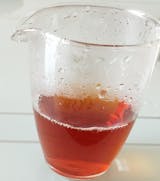Tie Luo Han - Iron Arhat Wuyi Rock Oolong
Encounter a heart-warming tea container, taking a sip or two of light and elegant tea in the middle of a busy schedule; between touch and vision, clearly comprehend heaven, earth and people of nature and ingenuity.

Frequently Bought Together
- Tie Luo Han "Iron Arhat" Wu Yi Shan Rock Oolong Tea
- Type: Rock Tea (YanCha)
- Cultivar: Tie Luo Han
- Origin: Wuyishan, Fujian
- Harvest Date: 2025/08/20
- Storage Methods: Sealed, Prevent moisture, Vacuum, Alone
- Tea Master: Jiang Guiming
- As one of four famous rock wulong teas along with Da Hong Pao (Big Red Robe), Shui Jin Gui (Golden Water Turtle) and Bai Ji Guan (White Rooster Crest), Tie Luo Han really represents rock wulong tea’s bold, complex character. These rock wulongs develop a rich mineral aftertaste from growing the mineral rich soil of Wuyishan in Fujian Province. This unique characteristic is known as yan yun or “rock rhyme.”
-
LEGENDS AND HISTORY OF TIE LUO HAN
The story of Tie Luo Han Tea comes from different legends, one about a monk named Ji Hui at Hui Yuan Temple on Wuyi Mountain. People called him the "Iron Arhat" because he looked strong like a statue.Master Ji Hui was good at picking and making tea leaves. His tea smelled nice and tasted full and sweet. People around Hui Yuan Temple liked his tea.
One day, Master Ji Hui found a tea tree in a rocky pit. It had tall branches, soft buds, and smelled good. He picked the leaves, made rock tea at Hui Yuan Temple, and invited villagers to taste it. The villagers loved the smell and praised the tea. They asked Ji Hui about the tea's name. He said it didn't have a name yet and told them how he picked the leaves. After hearing his story, they agreed he found the tea tree and knew how to make tea. So, they named the tea "Iron Arhat."
The original Tie Luo Han mother bush was found near Nei Gui Cave, high in the mountains. This bush was given the name Iron Monk to represent monks who developed their spiritual practices in this region. Legends tell stories of these special monks who practiced kung fu everyday in order to guard the temple and to chase thieves away. According to Chinese culture, after you exercise, you drink tea. They would pick tea near the cave after practice and make tea from the fresh leaves, which tasted especially wonderful during tea season.
The Tie Luo Han tea bush was mentioned as far back as the Song Dynasty (960-1279) as having excellent flavor and strong branches. The bushes themselves resemble a willow tree with thick shiny leaves with large veins. Guo Bo Cang wrote in 1886 about how Tie Luo Han bushes first became popular in making green tea during the Song Dynasty and later as the first of the four famous rock wulongs to become popular in the 17th century.
- The process for making Tie Luo Han resembles that of most rock wulongs. The fresh tea leaves are harvested, slightly sun-withered, and partially oxidized before frying, kneading, drying, and roasting. However, a few special traditional techniques at the oxidation and roasting stages truly raise this rock wulong to the next level.
- During the oxidation of the withered leaves, most wulongs are put through a ventilated rolling machine that tumbles the leaves to encourage oxidation. This method can produce excellent wulong. However, tea makers went the extra mile to oxidize this tea by the traditional tray-shaking method, where the tea is spread out on dozens of bamboo trays and each one needs to be intermittently shaken by hand over a period of several hours. The leaves also need to be carefully monitored to achieve the desired level of oxidation. This is both a highly labor-intensive task and one that requires a highly developed level of skill to gently toss and bruise the leaves on the trays.
- They are put through a kneading machine which compresses and kneads the leaves into their long twisted shape. After that, theTie Luo Han tea is dried to stability to make mao cha. The mao cha is already dried completely, but still has sprigs and unopened leaves that need to be sorted about before being roasted again. After the tea season is over they will sort out all the broken pieces and sprigs. Only then is it time for the charcoal roasting that develops Tie Luo Han’s particular character.
- Tie Luo Han tea has thick, twisted leaves, displaying a deep brown color with a gem-like sheen. The leaves look like frog skin with white spots, called "toad back." It smells strong, mixing orchid and fruit scents. The Tie Luo Han tea taste is robust, sweet, and refreshing, offering a smooth and has a rocky touch.
- After brewing, the Tie Luo Han is bright orange, and the leaves at the bottom are soft and even. It has a hidden aroma of flowers and fruits, even a hint of deep angelica scent. When you sip it, the tea flavor is full-bodied. You will feel a strong taste and slight bubbles in your throat. The aftertaste is a harmonious blend of fragrance, sweetness, and complexity, enduring through multiple infusions. This Tie Luo Han Tea feels thick and smooth in your mouth, leaving a long-lasting sweet aftertaste with rocky undertones.











